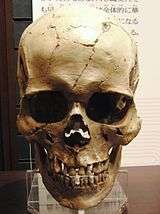Jōmon people
Jōmon people (縄文人 Jōmon jin) is the generic name of people who lived in the Japanese archipelago during the Jōmon period.
Morphological characters

On average, Jōmon adult men were about 155 cm (5 ft) and adult women were less than 150 cm (4.9 ft). They have so-called engraved deep facial features, the inter-eyebrows protrude, and the base of the nose is retracted. They have thick eyebrows, large eyes, double eyelids and somewhat thick chin bones.
They belong to the Proto-Mongoloid type, similar to Native Americans.
Language
It is generally believed that the languages spoken by the Jomon people are related to the today Ainu language.
Some linguists believe that the Ainu language and the Jomon language is an offshoot of the early proto-Uralic languages.[2][3]
The Japanese linguist Kanehira Joji believes that the Ainu language is related to the Uralic languages and show similar basic words, similar morphology and phonology, that become more and more similar the closer we get to the proto-languages. He further believes that the “siberian characteristics” in the today Japanese language is from an Ainu-Uralic influence and refers to the “dual-structure model” of Japanese origin between Jomon and Yayoi.[4][5]
Genetics
A genetic research from 2016, comparing East Asians, Siberians and Native Americans, showed that the Ainu (and Jomon samples) are compared to all other Asians most closely related to Northeast Asian Siberian populations and some northern Native Americans. The study did not find any genetic relations between Tibetans, Andamanese and Ainu (in modern times, they have many Haplogroup D-M174 people like Japanese), suggesting the already existing view that y-DNA Haplogroups do not show close relationships at all.[6]
Y-DNA
It is thought that the Haplogroup D1b (Y-DNA) was frequent in Jōmon people. In fact, a Jōmon man excavated from Rebun Island was found to belong to Haplogroup D1b2a(D-CTS 220)[7]. Haplogroup D1b is found in about 40% of modern Japanese people, so more than one-third of Japanese people are direct Y-DNA descendants of Jōmon people. In addition, it is assumed that the C1a1 and C2 existed in small amounts in Jōmon people[8], but the majority group was D1b.
mtDNA
MtDNA Haplogroup of Jōmon people is characterized by M7a, N9b. M7a is the highest frequency in Okinawa and N9b is in Hokkaido. In addition, B and F are found from Jōmon people.[9]
ATL retrovirus
The gene related to Jōmon people is a retrovirus of ATL (human T lymphotropic virus, HTVL-I). This virus was discovered as a cause of adult T cell leukemia (ATL), and research was advanced by Takuo Hinuma of Kyoto University Virus Research Institute.
Although it was known that many virus carriers existed in Japan, it was not found at all in neighboring countries of East Asia. Meanwhile, it has been found from many Native Americans, Tibetans, Siberians, Burmese people, some Polynesians, etc. Looking at distribution in Japan, it is seen particularly frequently in southern Kyushu, Nagasaki prefecture, Okinawa and Ainu. And it is seen at medium frequency in the southern part of Shikoku, southern part of the Kii Peninsula, the Pacific side of the Tōhoku region (Sanriku) and Oki Islands. Overall, ATL retrovirus was found to be more in remote areas and remote islands. When examining the well-developed areas of ATL in each region of Kyushu, Shikoku, and Tōhoku in detail, carriers are preserved at high rates in small settlements that were isolated from the surroundings and inconvenient for traffic.
The path of natural infection of this virus is limited to vertical infection between mothers and horizontal infection between males and females.
Based on the above, Hinuma concluded that the high frequency area of this virus indicates the high density remain of Jōmon people[10].
Culture
They had the "Jōmon culture", based on food collection and early farming and agriculture. They gathered tree nuts and shellfish, laid the foundations for living such as hunting and fishing, and also made some cultivation[11]. They used stoneware and pottery, and lived in a pit dwelling. They believed in animism and practiced ancestor worship.
References
- ↑ http://shinkan.kahaku.go.jp/kiosk/nihon_con/N2/KA2-1/japanese/TAB1/img/M01_g03_con.png (in Japanese)
- ↑ THE PHONO-TYPOLOGICAL DISTANCES BETWEEN AINU AND THE OTHER WORLD LANGUAGES AS A CLUE FOR CLOSENESS OF LANGUAGES - Yuri Tambovtsev Department of English, Linguistics and Foreign Languages of KF, Novosibirsk Pedagogical University, 28, Vilyuiskaya Str., Novosibirsk, 630126, Russia
- ↑ Proto-Uralic—what, where, and when? Juha JANHUNEN (Helsinki)
- ↑ "日本語の意外な歴史" (in Japanese). Retrieved 2018-08-21.
- ↑ 日本語の意外な歴史 第1話 金平譲司 Joji Kanehira
- ↑ Jeong, Choongwon; Nakagome, Shigeki; Rienzo, Anna Di (2016-01-01). "Deep History of East Asian Populations Revealed Through Genetic Analysis of the Ainu". Genetics. 202 (1): 261–272. doi:10.1534/genetics.115.178673. ISSN 0016-6731. PMID 26500257.
- ↑ 神澤ほか(2016)「礼文島船泊縄文人の核ゲノム解析」第70回日本人類学大会 (in Japanese)
- ↑ 崎谷満 (2009)『DNA・考古・言語の学際研究が示す新・日本列島史』勉誠出版 (in Japanese)
- ↑ 篠田謙一『日本人になった祖先たち—DNAから解明するその多元的構造』日本放送出版協会・NHKブックス、2007年 (in Japanese)
- ↑ Takeo Hinuma (1998) "From the virus to Japan Explore the Origin of Human "" Journal of Japanese Rural Medicine ", 46 (6), 908-911
- ↑ Crawford, Gary W. (2011). "Advances in Understanding Early Agriculture in Japan". Current Anthropology. 52 (S4): S331–S345.